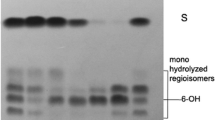Abstract
Ten lipases and esterases have been examined to catalyse the reaction between p-nitrobenzaldehyde and methyl vinyl ketone, the Baylis–Hillman reaction, to form 3-[hydroxyl-(4-nitrophenyl)-methyl]-but-3-en-2-one. Among these enzymes, Escherichia coli BioH esterase had the best activity. Optimal conditions for this reaction were: 0.1 mmol aldehyde, 0.1 mmol activated alkene, 30 mg E. coli BioH, 1 ml acetonitrile at 30 °C for 96 h. In addition to the named substrates, four other aldehydes and three activated alkenes were also investigated to determine the substrate range of the enzyme. The structures of nine products were confirmed by NMR and yields of the corresponding products ranged from 21 to 46 %.



Similar content being viewed by others
References
Basavaiah D, Veeraraghavaiah G (2012) The Baylis–Hillman reaction: a novel concept for creativity in chemistry. Chem Soc Rev 41:68–78
Bjelic S, Nivón LG, Çelebi-ölçüm N, Kiss G, Rosewall CF, Lovick HM, Ingalls EL, Gallaher JL, Seetharaman J, Lew S, Montelione GT, Hunt JF, Michael FE, Houk KN, Baker D (2013) Computational design of enone-binding proteins with catalytic activity for the Morita–Baylis–Hillman reaction. ACS Chem Biol 8:749–757
Chen YL, Li W, Liu Y, Guan Z, He YH (2013) Trypsin-catalyzed direct asymmetric aldol reaction. J Mol Catal B Enzym 87:83–87
Khersonsky O, Tawfik DS (2010) Enzyme promiscuity: a mechanistic and evolutionary perspective. Annu Rev Biochem 79:471–505
López-Iglesias M, Busto E, Gotor V, Gotor-Fernándes V (2011) Use of protease from Bacillus licheniformis as promiscuous catalyst for organic synthesis: applications in C–C and C–N bond formation reactions. Adv Synth Catal 353:2345–2353
Ma JB, Wu L, Guo F, Gu JL, Tang XL, Jiang L, Liu J, Zhou JH, Yu HW (2013) Enhanced enantioselectivity of a carboxyl esterase from Rhodobacter sphaeroides by directed evolution. Appl Microbiol Biotechnol 97:4897–4906
Reetz MT, Mondiere R, Carballeira JD (2007) Enzyme pomiscuity: first protein-catalyzed Morita–Baylis–Hillman reaction. Tetrahedron Lett 48:1679–1681
Strohmeier GA, Sovic T, Steinkellner G, Hartner FS, Andryushkova A, Purkarthofer T, Glieder A, Gruber K, Griengl H (2009) Investigation of lipase-catalyzed Michael-type carbon–carbon bond formations. Tetrahedron 65:5663–5668
Tang XL, Liu J, Wang B, Yu HW (2011) Cloning, screening and characterization of enantioselective ester hydrolases from Escherichia coli K-12. World J Microbiol Biotechnol 27:129–136
Wang JL, Li X, Xie HY, Liu BK, Lin XF (2010) Hydrolase-catalyzed fast Henry reaction of nitroalkanes and aldehydes in organic media. J Biotechnol 145:240–243
Wang J, Wang D, Wang B, Mei ZH, Liu J, Yu HW (2012) Enhanced activity of Rhizomucor miehei lipase by directed evolution with simultaneous evolution of the propeptide. Appl Microbiol Biotechnol 96:443–450
Xue Y, Li LP, He YH, Guan Z (2012) Protease-catalysed direct asymmetric Mannich reaction in organic solvent. Sci Rep 2:761
Acknowledgments
This work is financially supported by the National Natural Science Foundation of China (21176215/21176102), the Outstanding Young Scholar Grant of Zhejiang University (R4110092) and the Program for Zhejiang leading team of S&T Innovation (2011R50007). We thank all the members of Professor Yu’s group.
Author information
Authors and Affiliations
Corresponding author
Electronic supplementary material
Below is the link to the electronic supplementary material.
Rights and permissions
About this article
Cite this article
Jiang, L., Yu, Hw. An example of enzymatic promiscuity: the Baylis–Hillman reaction catalyzed by a biotin esterase (BioH) from Escherichia coli . Biotechnol Lett 36, 99–103 (2014). https://doi.org/10.1007/s10529-013-1329-9
Received:
Accepted:
Published:
Issue Date:
DOI: https://doi.org/10.1007/s10529-013-1329-9




